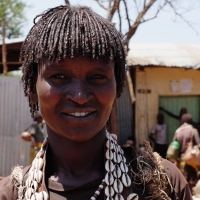 To go into Kenya from Ethiopia there are two routes we could follow. The first route runs from Moyale in Ethiopia to Marsabit in Kenya. A route known for the poor condition of the road and the many freight trucks and also the road that is sometimes referred to as the “Bandit Road”. The second option is from Omorate in Ethiopia, along Lake Turkana, to Maralal in Kenya. This route leads through a remote part of Kenya without any tarmac roads for over 800km, where facilities are far away and where gasoline, food and water is hard to get. But this is also the route through one of the most beautiful and unspoiled parts of Kenya. We chose to follow the Turkana route.
To go into Kenya from Ethiopia there are two routes we could follow. The first route runs from Moyale in Ethiopia to Marsabit in Kenya. A route known for the poor condition of the road and the many freight trucks and also the road that is sometimes referred to as the “Bandit Road”. The second option is from Omorate in Ethiopia, along Lake Turkana, to Maralal in Kenya. This route leads through a remote part of Kenya without any tarmac roads for over 800km, where facilities are far away and where gasoline, food and water is hard to get. But this is also the route through one of the most beautiful and unspoiled parts of Kenya. We chose to follow the Turkana route.
Still, this sounds easier than it is. The advise on the Turkana route is: “Do not travel alone.” The area is remote and difficult to reach, so help is far away when you go get stuck in the mud, have engine troubles or -even worse- get hurt. And in addition to that, we cannot take enough water, food and fuel on the bikes to cover the entire track. Space is limited. We would therefore only ride the Turkana Route if we would meet another traveller who would want to travel with us and who would be willing to carry our fuel on the roof of his car. But gasoline on the roof of the car; that is not something everyone would agree to. And besides that, there are currently not many overlanders in Africa anyway. Yet, against all odds, we did find a travel companion!
We had placed a message in the guest book at Tim & Kim Village: “Wanted: fellow traveller for the Turkana Route”. One week later we received an email from Pim. He wanted to ride the Turkana route and was willing to take fuel on the roof of his Land Cruiser. He also 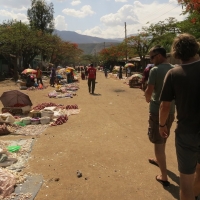 mentioned that he had met another Dutch couple that might want to ride along Lake Turkana. In Addis Ababa we met Pim, we planned the route and came into contact (via e-mail) with Jan and Margriet. Peter and I went to Arba Minch, where we would meet Pim again to do some shopping. After that we would drive with Pim to Turmi in the Omo Valley. There we would meet Jan and Margriet to convoy to Kenya. A good plan!
mentioned that he had met another Dutch couple that might want to ride along Lake Turkana. In Addis Ababa we met Pim, we planned the route and came into contact (via e-mail) with Jan and Margriet. Peter and I went to Arba Minch, where we would meet Pim again to do some shopping. After that we would drive with Pim to Turmi in the Omo Valley. There we would meet Jan and Margriet to convoy to Kenya. A good plan!
———-
It is warm in Arba Minch. During the day the temperature rises far above 30 degrees Celsius and at night it does seem to get any cooler. Even the thin cotton sheet we sleep in is too hot. Bonding with sweat, we are awakened at dawn by the announcer of the Orthodox Christian Church across from our hotel. Over an hour we hear him sing one song after another, very loud and quite out of tune. Sleeping is out of the question then. Just like an refreshing shower, as there again is no water. Alas, with some wet wipes and lots of deodorant we sit down for breakfast a little later “not-clean- but-all-fresh”. We have some coffee to regain energy for the rest of the day.
After breakfast Pim joins us and together we go out to do some shopping. We have calculated that we need about six days to drive to Maralal (Kenya). According to the information we found on the Internet, we would be able to find fuel, food and water there. Therefore we take food for six days. Fresh vegetables for the first few days, but cans of vegetables for the next few days, because in this weather vegetables  go bad without a refrigerator very quickly. In Arba Minch we can get anything we want to take: pasta, rice, cans of tuna, cans of peas, tomato paste, noodle soup, biscuits, jam, peanut butter and even chocolate paste and Snickers! With this we can get a long way!
go bad without a refrigerator very quickly. In Arba Minch we can get anything we want to take: pasta, rice, cans of tuna, cans of peas, tomato paste, noodle soup, biscuits, jam, peanut butter and even chocolate paste and Snickers! With this we can get a long way!
We also need drinking water for six days. In this hot weather we both drink lots of water. Especially when we leave the asphalt, we drink at least three litres per person per day. To make sure that we have enough water, we end up buying more than 40 litres of drinking water in large bottles of two or five litres. We cannot bring all this on our own bikes and are happy we can put this in Pims car.
Then the extra fuel. Through the reception of the hotel we buy three cans in which we can take gasoline and water. They are large yellow cans which were used for cooking oil. Perhaps not quite “CE certified” to transport fuel, but for those few days it will be fine. With two of the cans on our bikes we drive to a gas station in the city centre. Initially the attendant refuses to fill the cans with fuel. He points at a sticker on the pump that says: “No plastic containers.” At the same time, at least three tuktuks are fulling the same plastic cooking oil cans at the pump next to us. If we point to the plastic IMS tank on our motorbike and take another look at the tuktuks beside us, he gives in and fills the cans.
Back at the hotel we fill the third can with tap water. We cannot use it as drinking water, but if we boil the water we can use it for rice, pasta, tea and coffee. And we can also use it to wash and do the dishes. It takes some time to fit our three jerry cans, next to the cans of Pim on the roof of his car, but it fits. After an hour, the fuel and the “cooking water” are rock solid strapped to the rack.
The next morning Pim arrives at our hotel early in the morning. We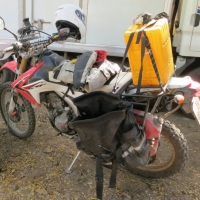 have breakfast together and again head for the market in Arba Minch to buy fresh vegetables and bread. Peter stays with the packed engines and I go to the market with Pim. When we come back, we cannot even see Peter. There are so many people around him. They all want to see the motorbikes and preferably touch all buttons. It is too hot to be standing in the full sun, we should get on the road to have some airflow. When I start my engine and open the throttle a bit, most bystanders take a few steps back and I have enough space to turn the bike and drive away.
have breakfast together and again head for the market in Arba Minch to buy fresh vegetables and bread. Peter stays with the packed engines and I go to the market with Pim. When we come back, we cannot even see Peter. There are so many people around him. They all want to see the motorbikes and preferably touch all buttons. It is too hot to be standing in the full sun, we should get on the road to have some airflow. When I start my engine and open the throttle a bit, most bystanders take a few steps back and I have enough space to turn the bike and drive away.
We leave Arba Minch and drive along Lake Abaya south to Konso. We drive on a beautiful paved road along golden fields in which people are at work in the blazing sun. The landscape is very different than in northern Ethiopia. Less mountains, much lower and much warmer. On 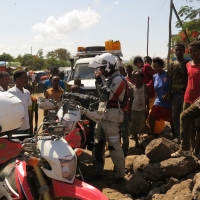 the road dozens of women and girls are carrying huge bundles of branches on their back. Apparently a task for the women, because throughout Ethiopia we have not encountered a man carrying such bundles of wood. We pass a river that is buzzing with people. In the small trickle of water in the wide riverbed people stand to wash, cattle are drinking, laundry is done and mopeds are polished.
the road dozens of women and girls are carrying huge bundles of branches on their back. Apparently a task for the women, because throughout Ethiopia we have not encountered a man carrying such bundles of wood. We pass a river that is buzzing with people. In the small trickle of water in the wide riverbed people stand to wash, cattle are drinking, laundry is done and mopeds are polished.
Every time we stop to take a picture or to eat something, there is a group of Ethiopians around us within seconds. “Where are you go?” is a question that is often asked. To date, we are still not entirely clear whether they want to know where we come from or where we are going. It is even very doubtful whether they themselves know what they ask us. It often happens that we properly answer the questions and then ask a question ourselves to make a chat, but get the exact same questions again as their response: “Where are you go?” or “How are you?” or “What is your name?“.
 The road from Konso to Weita (also known as Woyto) still consists of smooth asphalt, but once we take the exit to Arbore we drive on a gravel road. The first kilometres of at least another 800km without asphalt. It is dry and the road is good to drive on. That is a different story in the rainy season. The wide rivers are then full of water, blocking the roads and cutting off the villages from the outside world. The roads chance in muddy paths with deep tracks that are not easy to ride on for the most traffic. Our guidebook evens described the Omo Valley as a ‘No-Go Area’ in the rainy season. The rainy season is about to start, so we should not travel too slow and just keep driving now the roads are still passable.
The road from Konso to Weita (also known as Woyto) still consists of smooth asphalt, but once we take the exit to Arbore we drive on a gravel road. The first kilometres of at least another 800km without asphalt. It is dry and the road is good to drive on. That is a different story in the rainy season. The wide rivers are then full of water, blocking the roads and cutting off the villages from the outside world. The roads chance in muddy paths with deep tracks that are not easy to ride on for the most traffic. Our guidebook evens described the Omo Valley as a ‘No-Go Area’ in the rainy season. The rainy season is about to start, so we should not travel too slow and just keep driving now the roads are still passable.
We drive on, further into the Omo Valley. The area is known for the 24 tribes that live there, each with their unique characteristics. Well known tribes like the Mursi (famous for the clay plate in their lip), Hamer (known for their muddy dreadlocks) and Karo (known for the painting their bodies). Although the roads are pretty good to ride, we cannot ride great distances because the average speed on some stretches is quit low. A distance of 20km may take 30 minutes, but depending on the condition of the road can easily take an hour.
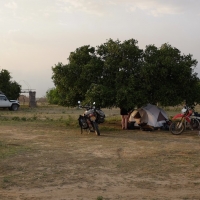 At the end of the afternoon we arrive in Arbore. A village that consists of no more than a handful of huts. The village also has a campsite. Although it is not much: there is no running water, no electricity and the toilet is a squat toilet over a hole in the ground. But at least we can camp quietly, because there is a large fence around the field and at the gate is a friendly security guard who keeps most bystanders at some distance. We are welcomed by some boys on a moped that offer to bring us some cold drinks. After a long a hot day that sounds like a great plan. The drinks at the camp are not cold yet, but once the generator has run for a while in the evening we receive our drinks. Not really cold, but colder than the outside temperature and even warm beer and lukewarm cola tastes OK after a day in the heat.
At the end of the afternoon we arrive in Arbore. A village that consists of no more than a handful of huts. The village also has a campsite. Although it is not much: there is no running water, no electricity and the toilet is a squat toilet over a hole in the ground. But at least we can camp quietly, because there is a large fence around the field and at the gate is a friendly security guard who keeps most bystanders at some distance. We are welcomed by some boys on a moped that offer to bring us some cold drinks. After a long a hot day that sounds like a great plan. The drinks at the camp are not cold yet, but once the generator has run for a while in the evening we receive our drinks. Not really cold, but colder than the outside temperature and even warm beer and lukewarm cola tastes OK after a day in the heat.
The next day we drive to the south-west, to Turmi . The route is beautiful! Golden yellow gravel paths lined with low acacia trees and the occasional small antelope (dikdik) and beautiful birds. This is real Africa! We pass several tribal members wo let their cattle graze among the acacia trees. They look beautiful with painted faces, beautiful hairstyles, special clothing and beautiful jewelry. We find them as interesting as they find us. If they have not run off the road in fear, they stands as if petrified with an open mouth staring at us. If we wave at them, we often only get a response when we already are 100 meters away.
 At the end of the morning we arrive at ‘Mango Campsite’ in Turmi. A beautiful campsite along a now still dry river. We find a spot in the shade of the large mango trees and set up our tent. Then we get into the car with Pim to go to Dimeka. It is Saturday and market day in Dimeka. Hamer-people from the surrounding area all come to the market today to buy and sell stuff. The closer we get to Dimeka, the more villagers we encounter that are on their way to the market with their cattle. Once in Dimeka it appears that all tourists have gathered at the Tourist Hotel. In the courtyard of the hotel a large number of Land Cruisers is lined up. The terrace is full with a large group of Belgians that are listening to the story of their travel guide. Once we have eaten something, we are assigned a guide. He takes us to the market, tells us about the Hamer people and calmly answers all our questions.
At the end of the morning we arrive at ‘Mango Campsite’ in Turmi. A beautiful campsite along a now still dry river. We find a spot in the shade of the large mango trees and set up our tent. Then we get into the car with Pim to go to Dimeka. It is Saturday and market day in Dimeka. Hamer-people from the surrounding area all come to the market today to buy and sell stuff. The closer we get to Dimeka, the more villagers we encounter that are on their way to the market with their cattle. Once in Dimeka it appears that all tourists have gathered at the Tourist Hotel. In the courtyard of the hotel a large number of Land Cruisers is lined up. The terrace is full with a large group of Belgians that are listening to the story of their travel guide. Once we have eaten something, we are assigned a guide. He takes us to the market, tells us about the Hamer people and calmly answers all our questions.
Trading on the market is a little quiet. Most of the people seem to have come to the market to chat, to exchange the latest gossip and to flirt. Way more fun than just selling goats. Women and children under one tree and men under another tree in the shade. Most of them wear traditional clothing consisting of animal skins decorated with beads and beautiful necklaces. Some people, especially the younger generation, sometimes wears western clothing and shoes. Especially the younger girls wear a bra over their 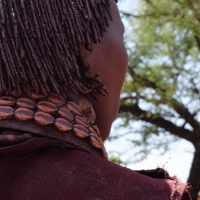 goatskin. The most particular still remains the hair of the Hamer people. They are known for the ocher-colored clay dreadlocks. They make them with butter and ocher-coloured sand which they smear in their hair. A peculiar sight, but also a peculiar smell. The butter in their hair starts to smell quite bad after a while in the sun. And there is also a strong ‘cattle -sent”, like being in the middle of a large goat state. An hour on the market is really enough.
goatskin. The most particular still remains the hair of the Hamer people. They are known for the ocher-colored clay dreadlocks. They make them with butter and ocher-coloured sand which they smear in their hair. A peculiar sight, but also a peculiar smell. The butter in their hair starts to smell quite bad after a while in the sun. And there is also a strong ‘cattle -sent”, like being in the middle of a large goat state. An hour on the market is really enough.
We walk along the stalls and look at all the beautifully dressed people. And all completely at ease, as -for the first time in a long time (and unique to Ethiopia)- we are left alone. There is no one who comes to us to ask for money, for a pen, for water or for food. The people on the market are primarily concerned with themselves and do not seem to take any notice of us. We are now the ones that watch and approach them. It does feel a bit awkward, like being in the Zoo, the way we watch their every move. Even more so since we have to pay for portraits we take after we have negotiated about the price per photo. But still it was very special and definitely worth the visit.
After an hour on the market and a lukewarm coke we get back in the car and back to the campsite in Turmi. Jan and Margriet have now also arrived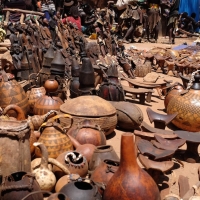 . We exchange stories, get a tour in their beautiful Land Cruiser Camper and trudge to the adjacent Buska Lodge for a warm beer. We hear that a “Bull Jumping” ceremony will take place in Turmi on Monday. We agree to stay in Turmi on Sunday, visit the ceremony on Monday and then together drive to Omorate afterwards.
. We exchange stories, get a tour in their beautiful Land Cruiser Camper and trudge to the adjacent Buska Lodge for a warm beer. We hear that a “Bull Jumping” ceremony will take place in Turmi on Monday. We agree to stay in Turmi on Sunday, visit the ceremony on Monday and then together drive to Omorate afterwards.
More about our visit to the Bull Jumping ceremony in the following message.
Click here to see the photos in this post.
Driving distance to Turmi: 12,734km (7,912.5 miles)
PS : Thanks for all the comments we receive on the website, for the nice emails we receive and the messages posted on Facebook. Really very nice to read that so many enjoy reading about our adventures. We cannot send everybody a personal message each time, so hereby a quick note to let you all know we really appreciate it. THANKS!
Previous story ““Boerenkool” and “Bitterballen”” – Next story “Turkana Route II – Bull Jumping“





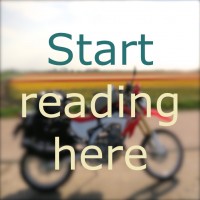


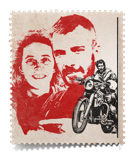
Die vals, zingende man hebben Leon en ik ook vervloekt haha! Echt vals he? Wat gaaf dat jullie langs als die volkeren zijn gegaan; het klonk als iets uber toeristisch, maar het feit dat jullie met rust gelaten werden zegt genoeg Heerlijk om een beetje mee te genieten, xxx
Heerlijk om een beetje mee te genieten, xxx
Jullie ook bedankt
Liefs Astrid & Erik.
Gaaf dat jullie de Turkana route rijden. Voor ons zal het zeer waarschijnlijk de Moyale-Marsabit route worden. We kijken nu al uit naar jullie volgende update.
We genieten van jullie avonturen.
En kunnen niet wachten op een volgend reisverslag.
De fotoos geven een goed beeld.
Knap van jullie om alles zo in de pen te houden.
Jullie maken een relaxte indruk. Aangepast aan het land en het klimaat? Ga zo door. Een goede reis en veel plezier.
Ben en Anja